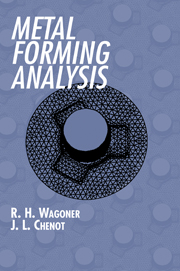Book contents
- Frontmatter
- Dedication
- Contents
- Preface
- Acknowledgments
- 1 Mathematical Background
- 2 Introduction to the Finite-Element Method
- 3 Finite Elements for Large Deformation
- 4 Typical Finite Elements
- 5 Classification of Finite-Element Formulations
- 6 Auxiliary Equations: Contact, Friction, and Incompressibility
- 7 Thermomechanical Principles
- 8 Sheet-Metal Formability Tests
- 9 Steady-State Forming Problems
- 10 Forging Analysis
- 11 Sheet-Forming Analysis
- 12 Recent Research Topics
- Index
7 - Thermomechanical Principles
Published online by Cambridge University Press: 05 July 2014
- Frontmatter
- Dedication
- Contents
- Preface
- Acknowledgments
- 1 Mathematical Background
- 2 Introduction to the Finite-Element Method
- 3 Finite Elements for Large Deformation
- 4 Typical Finite Elements
- 5 Classification of Finite-Element Formulations
- 6 Auxiliary Equations: Contact, Friction, and Incompressibility
- 7 Thermomechanical Principles
- 8 Sheet-Metal Formability Tests
- 9 Steady-State Forming Problems
- 10 Forging Analysis
- 11 Sheet-Forming Analysis
- 12 Recent Research Topics
- Index
Summary
This chapter is devoted to the analysis of the interactions between thermal phenomena and deformation processes. In hot forming, the effect of temperature is especially important, as in general the tools are used at relatively low temperature and thus produce a highly heterogeneous temperature field. For the workpiece itself, there is always a competition between the cooling effect that is due to the contact with tools and radiation plus convection on free surfaces on one hand, and heating by plastic deformating in the core of the part or by the friction dissipation on the surface in contact on the other hand. In fact, it may happen for forming of complex parts that the final result is cooling in some regions and heating in other regions. For a complete analysis of a forming sequence, different situations must be considered:
The preform can be heated in an oven and then transferred to the forming machine: in this case the strain and stress evolution can be neglected as a first approach, and a purely thermal analysis may be sufficient.
During the forming process, large plastic or elastoplastic deformation (respectively viscoplastic or elastic viscoplastic) is imposed on the workpiece, while the local slipping distance at the tool-part interface can also be important. A coupled thermal and mechanical analysis with large strain theory is therefore necessary.[…]
- Type
- Chapter
- Information
- Metal Forming Analysis , pp. 152 - 176Publisher: Cambridge University PressPrint publication year: 2001

